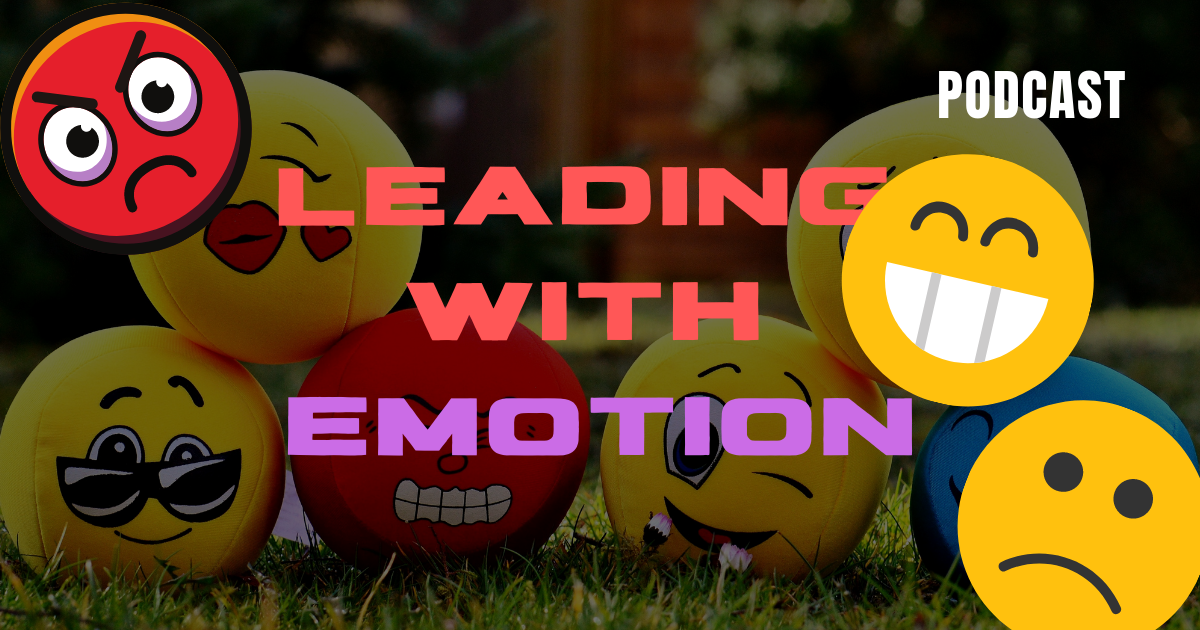“Leading With Emotion” Brief Summary of Show:
Leaders are often seen as strong, have an understanding of their own emotions, and are stereotyped into the common mindset that most of them “check their emotions at the door”. In this Inspired Action For Imperfect Humans podcast Christopher Lawrence and Kyle Kalloo discuss what leading with emotions means, why people believe and typically stereotype the idea that most leaders lead without emotion, and why leading with emotion can be considered a great strength!
Calls to Action:
Tell us your “inspired stories” stories by visiting www.InspiredActionPodcast.ca
Christopher Lawrence LinkedIn: https://www.linkedin.com/in/career-life-coach-christopher-lawrence/
Kyle Kalloo LinkedIn: https://www.linkedin.com/in/kyle-kalloo/
Change My Life Coaching & Change My Business Coaching LinkedIn: https://www.linkedin.com/company/6446498/admin/
Change My Life Coaching: https://changemylifecoaching.ca
Strategic Leader: https://strategicleader.ca
Resources:
A process model of self-regulation and leadership: How attentional resource capacity and negative emotions influence constructive and destructive leadership:
“Leading With Emotion” Transcript:
Tara looked at him and said, “John, I’m not your slave and I’m not your lackey. “I did my job. And maybe you needed to be here on time “so that you could help troubleshoot some of these issues. “And if you have a problem with it, “why don’t you deal with IT? “I am done working for you in this moment. “I am going to leave the room. Good luck.”
[Announcer] Is the thought of being imperfect keeping you from taking action? Welcome to “Inspired Action for Imperfect Humans”. Each week, we give you real life stories and thought-provoking research that inspires your soul to live a more fulfilled life through your own actions. From the heart of Calgary, Canada here are your hosts: Award winning coaches Christopher Lawrence and Kyle Kalloo.
Lady’s and gentlemen… I was going to pick on you for something there, but my automatic thought… I wanted to pick on you and I wanted to get it all out, but I interrupted my thought. I interrupted my thought, which caused me to laugh in that moment, which is why I stopped. Hello! Let’s start this again. Take two. Camera two. You’re up. Hey everyone! It’s Kyle Kalloo and Christopher Lawrence for another week of Imperfect Inspired Action podcast, where we’re going to talk a little bit about my favorite, absolute favorite subject, is leading with emotions. I know people know, who know me, are like, “Your favorite?” Christopher sometimes says I don’t have emotions. But let me ask you, Christopher, do I have emotions when I’m leading?
Definitely.
Mm-hmm. But?

Well there’s no but. You do. All leaders do. This is the thing that drives me nuts. Oh my God, here we go. Now you’ve got me up my ladder. If you want to know what that’s about, you need to listen to our last podcast. You got me up my ladder. This is the thing: It is impossible to bypass human emotion in the human brain. It is impossible to bypass it. Emotions are there to help us regulate. That’s why they exist. So all of these leaders who are like, “Check your emotions at the door.” That is their own emotional experience. If they’re like, “Think objectively. Be pragmatic.” Those are just words that they’re using as a metaphor for their own emotional experience. It is impossible to bypass human emotion. You cold hearted sons of bitches.
It just makes it so that we…
I’m talking to you, you know.
We have emotions. There is emotion. Because I hear that from some folks, I don’t know how many people you hear that from, your clientele, Christopher, because you do work with quite a few, you know, folks on the front line or just, you know, employees in careers in general. But I also hear that as well, where people are like, “Oh my God, my leader has no emotions.” “He has no emotions.” “She is emotionless.” “It’s like they don’t care.” “It’s like they can’t feel.” Right? All the things, and I’m telling you that’s not true. Because although I may not display a lot of my emotions, we do have them. Right? There’s times that we don’t allow it to be the only thing we filter and actually leverage in making decisions, because there’s some decisions you just have to make. Right? That is going to feel a certain way for some people, including yourself. However, it is necessary. Doesn’t mean that that leader doesn’t have emotions. And there is leaders who lead exclusively with maybe more or less or what the case may be with emotions. It doesn’t mean one way is better than the other. I believe, and I believe Christopher has a thought on this as well, is that you do need it in certain situations. In certain situation, it cannot just be emotionally led. What do you think?
Yeah, I totally agree with you. I’m curious, Kyle, do you have an example of when you, in your leadership, you were leading with emotions versus keeping your emotions tucked in the back? ‘Cause I know that you will more often keep them tucked in the back, which isn’t a bad thing. It’s not a bad thing. It’s just a different style. Do you have an example of where you led with emotions?
Yeah. I think there was a situation, I was working with an organization, a couple of folks on the team was complaining about certain things. And I just think this person that was doing that job, she was doing her job, but also she was the backup and also filling in on another job. And it seemed like she really wanted this other role that she was kind of babysitting for someone else, another leader. Right? And my operational brain just says, “No, she’s way more efficient at her first role. “That’s the role she’s supposed to be doing.” And that makes sense where she’s going to do that. And however, this other role would have been a little bit lower productivity, more time to train. It was going to take more resources, not only from me, but from other people in the organization. However, I got the impression that she was way more fulfilled by that role. That role played more into her values. That role, she enjoyed those tasks more. And so in a conversation, which I really intended to convince her to go back to her original role, that was really, if I’m being honest, that was really going to be my strategy. Let me just tell her how valuable she was in that other role, how much the organization meant for that role, but it didn’t factor in what is it that she found that was fulfilling. And so in my conversation with her, I saw her talking about this other role and she’s like, “I know I did this, and I know I could be doing this. “And I’m going to work with you harder there.” And I just thought to myself in that moment, you know what, I get it. I feel for her. I could see what that is. And it brought me to a place where I start to tell myself a story about the time when I wished someone had trusted me without experience, without knowledge, without certification to do that. Right? And I think that’s another topic I definitely, at some point, want to get into. Is do we hire people just for experience and all that other stuff? But in that moment, I thought to myself, I “felt”. Right? Didn’t “think”. I “felt” her in that moment. And I just said, “Okay let us find a way to make that work.”
That’s empathy.
Yeah. And she was blown away by it.

That’s empathy. It’s interesting. I would say that I have more examples of leading with emotion, than keeping my emotion tucked back, for sure. Which I think a lot of people see as a liability, actually. But here’s where it is a liability. It’s a liability when that emotion is unregulated and negative. So we grew up in three different kinds of households. There’s households that do not allow emotion. That’s my husband’s household, right? They didn’t, growing up, they didn’t have a lot of emotional labeling, So there was no emotion allowed, really. And it’s not that it wasn’t allowed, it’s just through the nature of the culture of that home, it wasn’t allowed. One of the other households, is that you’re allowed emotions, but there’s no boundaries on them. That was the household I grew up in. So it’s like, you could have emotion, but there was no limit. Like those emotions could just bubble into everything and anything. The most functional…
It’s interesting. Sorry to interrupt you there. It’s always interesting how these opposites always seem to attract people. Right?
It is interesting, isn’t it? Yeah.
You either have relationships with them, you either do business with them. It’s just interesting. Where it’s, when we grow up, we’re like, “Oh my God, I love this person. “I have so much in common.” A lot of times we don’t. And I think that’s what…
That’s right.
Anyway.
So yeah, the third one is, and this would be the most functional homes, the most functional homes allow emotions with boundaries. So it’s like, it’s okay to be angry. Right? It’s okay to be angry. It’s okay to cry. Right? And also like, let’s talk about what a healthy expression of anger looks like. So, like, you can’t just like be punching holes in walls or throwing things at people or hitting people. But you can be angry, and you can express what that anger looks like in a way that is not destructive. So it’s really interesting. I would say probably greater than 80% of the time, I lead with emotions. But what’s happened over the years is that now I lead like it’s more leading with emotions with boundaries. Although I have to say there are some great payoffs to leading without boundaries, too. I have a few examples of that. Where to be honest, I had a leader who made fun of somebody with a hearing disability, about their disability, and, girl, I led in that moment without boundaries. Without emotional boundaries. I flew off the handle, because I didn’t give a flying fuck in that moment.
In the Caribbean, we call that “you dirty them up.” You dirtied them up.
Oh and I did, girl.
Which is the official patois term is you dirty them up. Okay? Because that’s what needed to happen in that moment. I was talking about you to someone else. I think I was doing an interview, or something was happening, was talking about my business partner. And I said, “You know, why we work so well together “by it’s what we do, although I may have the head “on certain things,” which is when it’s necessary, because again, that doesn’t work in certain situations, as well, “you have the heart in most things.” Right? And so I said, “Although I work with a lot of these “senior leaders who are really trying to tap into that,” and I mentioned this to them as well, “what I love about what you do is you’re this advocate “for the front line.” Right? You’re the one who’s really bringing that stuff back into it, which I think is a great combination when we actually have some of those crossovers. Right? Because it can’t be all or nothing. For those people who are black and white, “Leave it checked at the door,” like you said earlier, or what have you, there are going to be moments either from a leader, when they tap into it, it’s always interesting when they come back after a few sessions, they say, “Yeah. So I did a little bit about that tapping into it “and having conversations and allowing myself “to go these places.” And he goes, “Wow, there’s a lot of emotions.” Right? “People are feeling a lot of things.” And I said, “Absolutely. And you’d see how “we can help them when we allow them to step into it. “And then also let them know when “the boundary is going to be required for here.” If you get really emotionally upset about something, you’re going into this massive meeting and just completely taking it over and letting everyone know that you have to be whatever, may not be most appropriate.
It’s interesting because…
But to pull me aside and say, “I really felt something in that moment, “and this is kind of what’s happening for me.” Yeah. That makes sense, too. Right?

Mm-hmm. I have an interesting example of this. There’s some of these old school guys that come from a different world, right? I’m not excusing behavior, I just, I have an appreciation that they are in a different world than, you know, grew up in their own different world than we grew up in. There is a guy named John who worked at TC Energy. And John was a contractor. He came back as a contractor, but he was past retirement age. But he was a fierce, fierce kind of guy. And he was the kind of guy that would come into a room, but he was well-respected for getting stuff done. And he would be the first one to say, “Check your emotions at the door.” Right? He was also the guy that would come into a room and fire a team of eight people in one sitting because he was pissed off. And it’s like, so this is the behavior that was rewarded. And I’m like, it’s because he can drive results, but he’s driving results at the cost of the human factor. And so I think to myself, like, and I’ll tell you what, I had a team member that I worked with, and she was young. She was just a young contractor. When I say just a young contractor, I only say the word “just” not to minimize her, but from the perspective of what she brought into that room. She did not usually lead with emotions. That wasn’t her way. They were often talked back. Right? But in that moment, she knew that she had to lead with emotions. She walked into a room, so she was working with the IT department. John was going to set up, he was doing this training. And every participant in this training had to have a laptop in front of them. And so they needed a port with all these connections in this meeting room that IT had to set up. So, Tara was setting up the meeting room with IT, and it wasn’t working. John comes strolling in late, it’s not working, and he tears us strip off of her in front of 25 people. And Tara looked at him and said, “John, I’m not your slave. And I’m not your lackey. “I did my job. And maybe you needed to be here on time “so that you could help troubleshoot some of these issues. “And if you have a problem with it, “why don’t you deal with IT? “I am done working for you in this moment. “I’m going to leave the room. Good luck.” And she left, and he was standing there not having the knowledge of the technology or anything. He was standing there holding the bag. Two things happened: The room stood up and gave her a standing ovation as she walked out the door, because he was a dick. The second thing is he came up to her after, and I witnessed this, with a smile on his face, and he says, “I respect you.” And they worked together for years. I just thought what an interesting story.
Wow, wow.
So I have two definitions for you here, Kyle, actually.
Okay, let’s do it.
Or a little bit of research and a definition.
I was just going to ask you that. Yeah.
So yeah. So Collins and Jackson in 2015 showed that leaders who were exposed to high levels of emotion effected their self-regulation. And it actually resulted in destructive leadership. But hang on, let me, firstly, lowering the level of negative emotions allowed leaders to self-regulate more effectively, giving rise to constructive leadership. So what the implication here is, is that actually leading with emotion is really important, but it’s leading with emotions with boundaries. In other words, we must lead with emotion. So what does leading with emotions mean? So I’ve got a definition here. Leading with emotions means observing and experiencing emotions in oneself, as well as an others,
I’d agree.
which requires being present the moment. So if you’re thinking about what you’re saying next, you’re not present in the moment.
Absolutely.

This also can include using silence in a team setting to create connections beyond what’s actually happening. So emotional intelligence is actually, part of emotional intelligence is about emotional granularity. You have to be able to understand emotional words and get really granular with those words. There’s actually emotion wheels that help with like, I’m feeling sad and it’s like, well, what level of intensity is that? And then finding a more appropriate word, like is it grief, or is it like a little bit of malaise? Or languishing or something. And so getting emotionally granular actually helps with emotional regulation. Most of us don’t learn emotional labeling growing up. But actually if we did, we would be more functional human beings and actually more functional leaders. And I would say, most leaders actually don’t do this.
Yeah. ‘Cause again, it’s just, it’s that pattern, the story that they have been told, as well, from other leaders, the mirroring of other leaders that they think is effective because they only see one side of it. And I think this week, the challenge really for you guys is to be thinking about, you know, your own leadership or the leaders you have been influenced by, and to really actually put that on the forefront to say, it’s not a bad thing if I’m leading with emotions. But like you said, if the behavior is destructive, then that is going to impact your leadership. Right? And if it’s not, then you be able to be mindful that it’s okay to step into it when appropriate. We often like to say “situation will dictate,” right? When it’s appropriate. And it’s not because you read somewhere or heard somewhere that says, no, no, I have to be a leader that they fear. I have to be a leader that I command and demand respect. No, it’s really about being mindful. Like that story I mentioned to you earlier. In that moment, I wanted to hear, I had every intention of putting my agenda there, but I was mindful of stopping that story and just listening to her. Just allowing her to express herself and even in moments where she was mindful of not being too emotionally excited about it, I asked her more questions about it. So that way I’m like, “Okay, but what would that do for you?” And so I could actively hear and listen. So leading with emotions is not a bad thing. So if your leader is not…
And…
Yeah, if your leader is not showing up a certain way…
I would just say that when Kyle talks about your challenge is to look at your leadership, that’s not just for leaders.
Absolutely.
That’s for everybody in any position in your life. Like, how are you leading in your family? How are you leading as the new employee in the company?
Right. Leading south, right? Plays a role in that. So until next week, again, our imperfect, inspiring challenge to you is look at how you’re leading in your leadership, in your life, and leading with others. Have a great week.
[Announcer] It’s our goal to build a global community of inspired action takers. And we can only do that with your help. So if you love inspired action, please leave a review on your favorite podcasting app and share us on your socials. You’ve heard from us, now we want to hear from you. Go to inspiredactionpodcast.ca and tell us what is the inspired action you took this week? Next week on “Inspired Action for Imperfect Humans”:
I think sometimes when we think about routine, should it start right away in the morning? Or is it something that you feel routine should have in the afternoon, in the evening? ‘Cause I just, using that phrase, I think there’s an opportunity where if you don’t start with routine, how could the rest of your day look like? What could the rest of day look like? Right?



